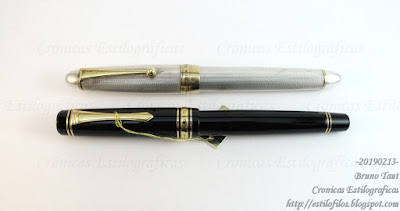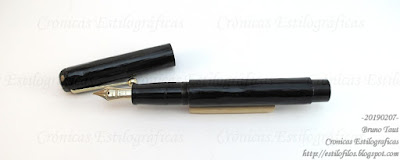For the occasion, Pilot created a flat top pen with a size 15 nib made of 18 K gold. It was a limited edition of 7500 units and cost JPY 50,000. This pen, as is also the case of its natural successor the Custom 845, has most of the cap and most of the body coated with urushi.

These are the nibs of the previous pens. Both are made of 18 K gold. The anniversary pen, a limited edition, has a special engraving for the occasion.
On that same year, Pilot had marketed the more luxurious versions of its workhorse fountain pen—the Pilot Custom 745 (FKK-5000G and FKK-5000MS) and 748 (FKK-8000G and FKK-8000MS), based on the Custom 742 and 743. These luxury pens had their bodies in vermeil (G models) or Sterling silver (MS models), and each of them had two possible decorative pattern: barleycorn and pinstripe. The 745s implemented size 10 nibs and cost JPY 50,000; and the 748s, size 15 nibs for JPY 80,000; on both cases with a gold purity of 18 K.
And this is the paradox—a limited edition with urushi cost less, a lot less, that the regular edition made of Sterling silver. All the rest is the same—nib, feed, filling system... JPY 50,000 vs. JPY 80,000.
It seems that in 1993, silver was a lot more valued than urushi. That does not seem to be the case nowadays on the Pilot catalog. Although there are some difference on the nibs, the Silvern series and the Custom 845 cost the same, JPY 50,000. And the second hand market also reflects this trend—limited editions preserve their value better than regular models.
Custom 745 and 748 were discontinued in Spring of 2007.
Iwase Seisakusho prototype with Henckel nib – Takeda Jimiku Hisoku
Bruno Taut
Chuo, February 12th 2019
Etiquetas: Pilot, mercado, urushi
Bruno Taut
Chuo, February 12th 2019
Etiquetas: Pilot, mercado, urushi











































